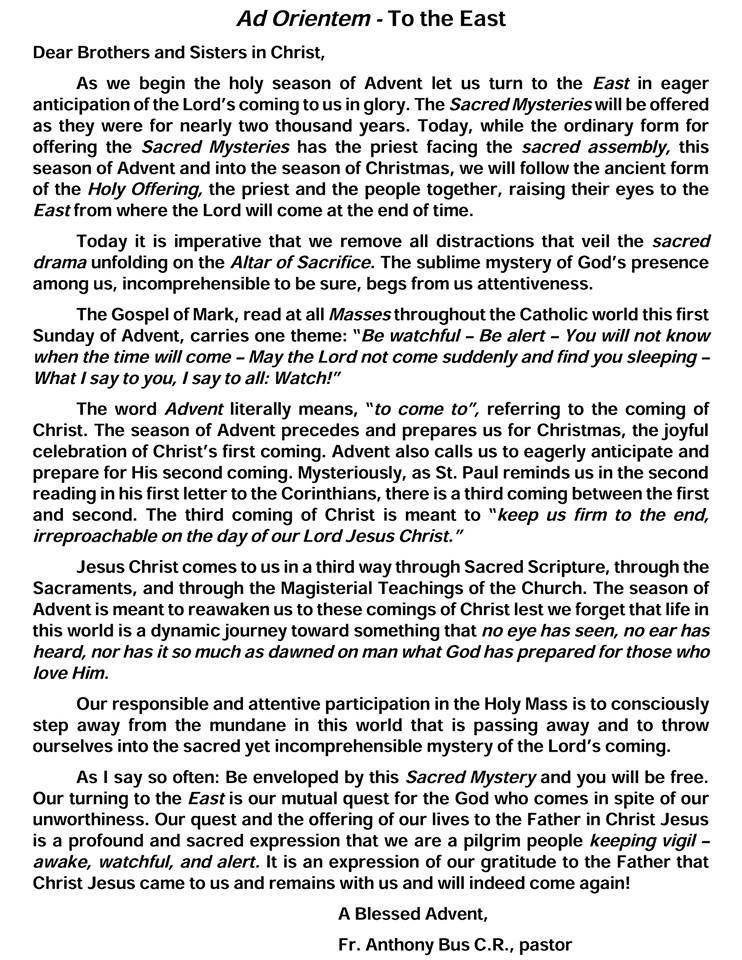From this source:
Celebrating Mass Ad Orientem (towards the East) or as most people wrongly say “with the priest’s back to the people” is an ancient practice that causes much bewilderment in modern Catholics.
The point of facing east is to emphasize the essential character of the liturgy: that of a procession out of time and into eternity in Heaven. We see and taste this procession in the course of the liturgy. The celebrant, standing in the person of Christ, leads the way, but we are all moving together, as a community and as the people of God, as part of the same procession that begins at the Introit, continues through the Offertory, and culminates with our reception of Holy Communion.
The practice offers a psychological and spiritual benefit. It permits the worshipper to contemplate the purely sacramental character of the Mass and focus less on the personality of the celebrant. From the celebrant’s point of view, it permits a more intense focus on the mystery of the sacrifice taking place rather than on the personalities of the worshippers.
Here are a few observations to keep in mind:
- Vatican Council II said nothing about the direction of the celebrant during Mass. It presupposed Mass ad Orientem. Mass facing east was the norm from ancient times and even during and after Vatican Council II. There has never been authoritative liturgical legislation requiring any change. The Roman Missal (official liturgical book from which Mass is celebrated) not only permits it, the rubrics actually presuppose it, (e.g., the priest is told to “turn toward the people” at the Orate Fratres (“Pray, brethren …)
- It has been the practice in the entire Church, East and West from time immemorial. Contrary to a prevailing misconception there is no evidence for celebration of Mass versus populum in the first nineteen centuries of the Church’s history, with rare exceptions. (Cf. The Spirit of the Liturgy, by Cardinal Ratzinger, pp. 74-84.) The practice of reducing an altar to a table for a service facing the people began only in the 16th century — with Martin Luther.
- Moving the altar closer to the nave, separating it from the reredos, and proclaiming the readings from the ambo are a welcome return to more ancient tradition and in harmony with the intent of Sacrosanctum Concilium. However, the almost universal celebration of the Mass versus populum, while permitted deprives the Mass of its traditional cosmic and eschatological symbolism.
- Churches have traditionally been constructed facing the rising sun. Facing East we are turned in expectation toward the Lord who is to come (eschatology) and we show that we are part of an act that goes beyond the church and community where we are celebrating, to the whole world (cosmos). In churches not facing geographical east, the Cross and Tabernacle become “liturgical East”.
The drama of salvation history is powerfully symbolized in the renewed liturgy when it is celebrated ad Orientem. The priest faces the people as he calls them to prayer. Then he turns to lead them in the common plea for mercy (Kyrie eleison). He prays on behalf of the people as he continues to face the Lord. He turns toward the people to proclaim the Word and instruct them. After receiving their gifts, he turns again to the Lord to offer the gifts to God. He then turns to the people to distribute the Risen Christ at the eucharistic banquet.
While there is some positive symbolism in Mass versus populum, there is also a very negative symbolism. “The turning of the priest toward the people has turned the community into a selfenclosed circle. In its outward form, it no longer opens out on what lies ahead and above, but is closed in on itself” (Ratzinger, p. 80).
“Despite all the variations in practice that have taken place far into the second millennium, one thing has remained clear for the whole of Christendom: praying toward the east is a tradition that goes back to the beginning. Moreover, it is a fundamental expression of the Christian synthesis of cosmos and history, of being rooted in the once-for-all events of salvation history while going out to meet the Lord who is to come again” (Ratzinger, The Spirit of the Liturgy, p. 75).

